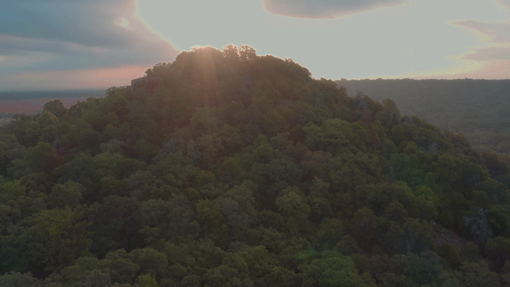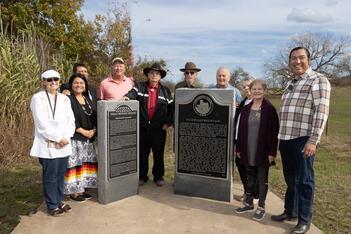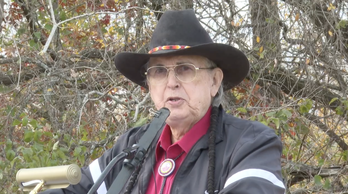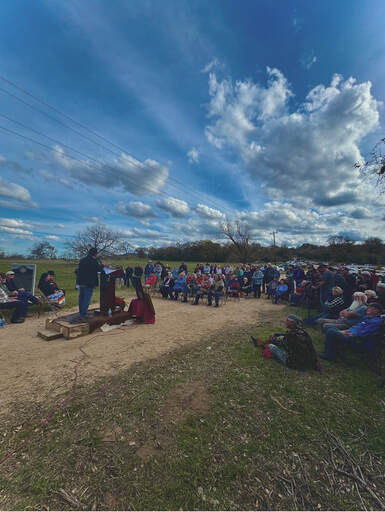
Don Patterson (Ricardo B. Brazziell/American-Statesman)
Almost exactly 140 years after the Tonkawa were expelled from Texas, they have returned to purchase Sugarloaf Mountain, a sacred site located in Milam County, northeast of Austin, that plays a key role the tribe's creation story.
"We're home," Tonkawa President Russ Martin said at a small Dec. 12 ceremony honoring the recovery of 60 acres of the tribe's ancestral lands in Central Texas. "The first time I got to the top of the mountain, I was overwhelmed. I'm not that spiritual a person, but that experience was spiritual. We're glad to be home in Texas."
The purchase of the land for a historical park is part of a larger movement, especially among Texas tribes that were expelled — or nearly exterminated — during the 19th century, to reclaim their legacies here.
Sugarloaf Mountain is a high conical hill of red sandstone that overlooks the prairies and bottomlands of the Little and Brazos rivers, which flow together just downstream of the landmark.
On those floodplains, a large village of several cooperative tribes, which the Spanish called Ranchería Grande, became the one of the most populous spots in Texas during the 1700s. So dense was the Indigenous presence that the Spanish planted three short-lived missions in what is now Milam County.
To the Tonkawa, Sugarloaf was known as Red Mountain, or "Natan Samox” in the Tonkawa language. According to one historian, the Spanish called it Turtle Mountain, or "La Tortuga."
It was a sentinel marker for the Spanish traveling along the braided Camino Real de los Tejas, which followed trails blazed by Native Americans from the Rio Grande to northwestern Louisiana.
In 1884, the Tonkawa, once called "the best friends of the Texans," were removed from Fort Griffin in northwestern Texas to first one and then another reservation in Oklahoma as part of their own "Trail of Tears." They had been moved previously in 1855 and 1859.
By the late 20th century, it was rumored that the Tonkawa had disappeared altogether.

On December 12th, 2023, the Tonkawa Tribe of Oklahoma purchased its place of origin in Central Texas. That place of origin, a mountain named Naton Samox meaning Red Mountain in the Tonkawa language, is the site of the tribe’s original creation story. The sixty acre tract near Gause Texas was purchased from Texas landowners who owned a larger parcel since 1995 containing that mountain. After the necessary preparations are concluded, the tribe will be making the site accessible to the public as a historic park, for public enjoyment of its beauty, as well as to educate the public about the tribe’s Texas history.

While the Tonkawa creation story had been passed down in its oral history for generations, after the tribe’s second and final removal to Oklahoma in 1884, the mountain’s exact location was lost. Using in part the old Spanish records, Donald Patterson rediscovered the mountain’s location in the early 1980s. Key to the rediscovery was the fact that the tribe was often said to reside at the confluence of the Brazos and Little Rivers, near what is today Gause Texas, a 30 minute drive Northwest of Bryan-College Station. Patterson later served multiple terms as President of the Tribe, and is now the oldest living male elder. Patterson has also filled the role of tribal historian for over fifty years. “This purchase would not have been possible without the effort of Don Patterson,” said Russell Martin. “While his list of accomplishments and his legacy is huge, I have a feeling that Don’s rediscovery of our sacred mountain might one day be considered his most important effort of them all.”

Once the mountain was rediscovered, the tribe immediately had hopes that the site could be preserved. In July 1986, tribal President Henry Allen spoke to the Austin American Statesman about Red Mountain being the birthplace of the Tonkawa. He also said “If there's some way we could get that back and make it a state park or a national park or a tribal park, whatever the case may be, we’d like to do that.” In that timeframe, Chief Allen hoped that the state might ultimately spend the money necessary to preserve the site that was so important to the tribe. “You don't take something from someone without offering something in return,” Allen told the paper.
In 1994, a Texas landowner who owned the mountain as part of a large tract of land was approached by treasure hunters seeking Spanish gold. With the landowners approval, the treasure hunters examined the mountain carefully, but found no minerals of value. Unsatisfied, the landowner began excavating the side of the mountain himself in a haphazard, irresponsible manner, to the dismay and outcry of local residents. Then Tribal President Virginia Combrink learned of the destruction of the mountain and visited Gause, writing open letters to local newspapers and calling on local residents to pressure the landowner to stop the mountain’s destruction. One week later, the digging stopped, but the mountain still bears the scars of the excavations. Having seen the mountain both before and after the destruction, Don Patterson describes the Red Mountain today as being like an apple with a bite taken out of it.
With the blessing of the tribal executive committee, the documentary crew researched the situation and learned of the Herzog’s desire to sell off the mountain. In 2023 the Herzog’s leased sixty acres containing the mountain to El Camino Real de los Tejas National Historic Trail Association (ElCaT), a lease which also included an option to purchase at a previously agreed sales price.

For the last eighteen months, the tribe has been working to produce a film that would tell their unusual story in a feature-length documentary format. The tribe, together with Sugarloaf Pictures’ director Andrew C. Richey, producer Bob O’Dell, and executive producer Felipe Adams, have been capturing the evolving story of the mountain and its purchase on film. The film, Tonkawa: They All Stay Together, has an expected release date of 2025.
Red Mountain is the first piece of Texas land ever purchased by the Tonkawa Tribe. The tribe has agreed to preserve and protect the land in perpetuity, and will work with ElCaT to open up the site for public access as soon as the needed preparations are complete.













